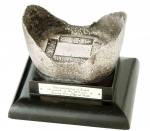Chinese silver ‘sycees’ given to Charles Rothschild (1877-1923) as a gift, c.1903. In 1903, Charles Rothschild made a Round-the-World trip, spending time in China.
These objects are a type of silver bullion that took the form of ingots called ‘sycees’ or ‘shoes’ because of their distinctive shape created by rocking the mould while the metal was still liquid. They were used throughout China in varying weights and sizes. Each ingot was stamped with the name of the smelter, date of casting and an indication of the weight and fineness.
Trade with China
The first firm evidence of business between N M Rothschild & Sons and China dates from 1838, In the earliest surviving letters from Rothschilds' agents in Canton, trade in Chinese silks feature considerably, alongside tin, tea, cochineal and quicksilver.
After 1858, N M Rothschild & Sons moved to expand these links. Much of the correspondence with their agents in Shanghai focused on silver, the medium of commercial payment in China. Trading and shipping of specie and bullion had, from the first, been a central pillar of the business of N M Rothschild and the firm was quick to organise a substantial trade to China.






















